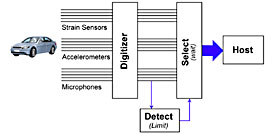
Event-Based Data Acquisition
Software Triggers Explained
NEWS FOR IMMEDIATE RELEASE |
|---|
|
For more information, contact |
Bellevue, WA, October 17, 2007 -- The purpose of many applications is to identify events of interest and to acquire data surrounding those events. One good way to do this can be to have an application acquire data on all channels and discard data unless events of interest occur on one or more channels. Microstar Laboratories has posted an article on the company Web site that explains how to do this with software triggers. You can define a trigger based on one of a number of attributes of data acquired on any channel: limit, slope, maximum, minimum, etc. You also can define a trigger as some combination of other triggers. And you can specify how much data to save before and after each trigger event. The article includes a brief discussion of hardware triggers, and points out – using a vehicle crash test as an example – how software triggers can offer a more reliable alternative.
Onboard Intelligence
Intelligent Selection
The PC receives only preselected data. The DAP board discards unneeded data in real time. Onboard intelligence executes software trigger commands on the DAP itself.
Microstar Laboratories makes Data Acquisition Processor (DAP) boards. If you use these boards for PC-based data acquisition, you can implement software triggers on the boards themselves rather than on the PC. Every DAP has an onboard processor running a real-time operating system that you control from a Windows application. You use this application to specify runtime behavior and to define the software triggers on the DAP. These are implemented in the part of your application that runs on the DAP board.
DAPstudio: a Windows Application
You can use DAPstudio, a Windows application, to define the software triggers described above. With DAPstudio you can specify the complete runtime behavior of any DAPs in your application. You then can run your application without requiring any other Windows software. You also can do this from LabVIEW, MATLAB, and other third-party software. And from C++, VB, and other applications that allow DLL calls.
Conclusion and Next Step
If your application has to identify events of interest and to acquire data surrounding those events, you may want to investigate software triggering. You could start by reading the article that Microstar Laboratories has recently posted on the company Web site. While you are visiting the site, download a full version of DAPstudio to evaluate it and to experiment with defining software triggers.
# # #
Editorial Overview:
Many applications acquire data surrounding events of interest. An article on the Web explains how to do this with software triggers. The technique lets the acquired data determine when an event of interest occurs. Software triggers offer more flexibility than hardware triggers, and may be more reliable, too. You can implement them on Microstar Laboratories Data Acquisition Processor (DAP) boards. Each of these has an onboard processor running a real-time operating system that you control from a Windows application. DAPstudio, a Windows application, lets you define software triggers that you implement on the DAP board itself, along with other runtime components of your application. Not only can you read the article on the company Web site, you also can download a full version of DAPstudio to evaluate it.
Note to the Editor:
Microstar Laboratories suggests this text as a caption for the available image:
A transient glitch can easily set off a hardware trigger. A software trigger can rely on processing to distinguish real events from noise. The article on the company Web site describes the processing applied to a microphone signal to make this distinction and so provide a reliable trigger.
Microstar Laboratories, Inc. claims Microstar Laboratories, Data Acquisition Processor, DAP, DAPL, and DAPstudio as trademarks.
Microsoft Corporation has registered Microsoft and Windows as a trademark. National Instruments Corporation has registered LabVIEW as a trademark. Other organizations may claim – or may have registered – as trademarks any trade names, logos, and service marks that appear in this document but not in the list above.
Microstar Laboratories makes it a practice to use an appropriate symbol at the first occurrence of a trademark or registered trademark name in a document, or to include trademark statements like this with the document.
